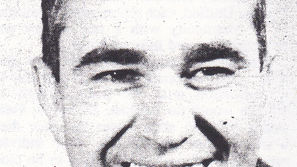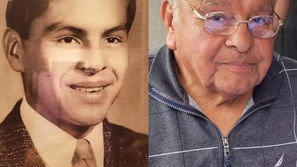Madera and the faith healer
- Bill Coate
- Oct 17, 2020
- 4 min read

Madera County Historical Society Faith Healer Avak Hagopian stands between two aides in 1947 as he prepares to meet Vaughn Arakelian, whom he hopes to cure of epilepsy.
Krikor Arakelian is a name that will always be remembered in Madera. As a 12-year-old boy, he immigrated to Fresno with his family from Turkish Armenia. At first, he worked on the family farm and then went out on his own. Eventually, he increased his acreage to include land in Fresno, Kings, Madera, Stanislaus and San Joaquin counties. He farmed grapes and raisins, and built the Mission Bell Winery in Madera. By the 1940s, he was worth $25 million. Arakelian had found the end of the rainbow, but there was one problem. His son, Vaughn, had epilepsy, which was naturally heartbreaking for the father.
For years, he spent thousands of dollars and turned to a host of physicians for a cure to his son’s illness but to no avail. He hired a nurse to be with Vaughn, and the family tried to deal with the situation as best it could. Then in 1947, Krikor heard about Avak Hagopian, a 20-year-old Iranian faith healer.
It was reported to Arakelian that Hagopian had been told by a divine voice that he had been called to be a faith healer, and from then on when he laid hands on sick people, they were healed.
In 1947, the elder Arakelian made contact with Hagopian. He sent him tickets to fly to America, and on May 6, he arrived by plane in Los Angeles, taking the media by a storm. Dressed in robes and wearing long, dark hair, he presented an almost mystical aura.
At that time the Arakelians maintained two homes — one in southern Madera County and the other in Palm Springs. Krikor took the faith healer to his desert estate, which once was owned by Barbara Hutton. There, the spiritual healer met Vaughn Arakelian for the first time.
Hopes for a miracle ran high. While hundreds of lame, deaf and blind people crowded around outside, Hagopian, known as “Avak the Great” in Iran, met Vaughn on the inside. He prayed for him and stroked his shoulders saying, “You are going to get well in a very short time.” He added that it would be several days before actual healing treatments began.
On May 9, Hagopian went on a special fast, eating only cheese and bread in solitude. He began his prayers and meditation, refusing to see anyone, not even his hosts, and refused to speak, except to say that he must not be disturbed.
Krikor Arakelian expressed disdain for the healer’s wide publicity. He pleaded with the nation’s sick to stay away from Palm Springs until he could see whether “Avak has real healing ability.” He went on to say that Hagopian doesn’t declare that he is a miracle worker, and “we ourselves do not know anything about him except what we read in reports from Iran.”
Meanwhile the crowds descending on the Arakelian property continued to grow. By May 21, Krikor decided that something had to be done, so he petitioned the Palm Springs City Manager William Allworth to allow Hagopian to use a surplus Army building to meet with the sick and disabled. This was denied, so the faith healer continued to treat the younger Arakelian while the older one tried to deal with the crowds. Because of the heavy correspondence from those asking appointments, the Arakelian family added two secretaries, two house attendants, two guards and a professional interpreter to the staff.
Hagopian, having moved into the Arakelian’s winter home in Palm Springs, suddenly announced on June 6, 1947, that he was going to take a 30-day vacation because of fatigue and warm weather. Rumors began to flow that he would establish a “faith healing institute” in Los Angeles.
By Sept. 16, the drama surrounding the Iranian faith healer had changed dramatically. Vaughn Arakelian and his faith healer were moved back to the family’s Madera home, and Avak the Great announced that he would conduct faith healings in Los Angeles’ Shrine Auditorium and then go on a special train tour through 34 states and three Canadian provinces. Meanwhile Krikor Arakelian refused to comment on whether or not his son had been healed.
Although Arakelian didn’t want to talk about it, the Madera Tribune didn’t hold back. In an editorial by Howard Clark, the paper took the whole enterprise to task.
“It is regrettable,” Clark wrote “that there was such publicity given the Armenian mystic before his faith healings could be proven or disproven. Failure will mean tragedy in countless homes where hopes have been keyed by the publicity.”
After Vaughn returned to his Madera home and Avak completed his train tour, the faith healer lost some of his charm and interest in him waned. He died in 1990 in Poughkeepsie, New York.
Krikor Arakelian, the hero of the story, died in 1951 and was buried in Fresno. In 1977, they brought his son to him. Vaughn had died on Feb. 25, never having been cured. The faith healer couldn’t do any more than the medical doctors could do, but Krikor did everything that was humanly possible.
He probably had more faith than anyone.


























Comments